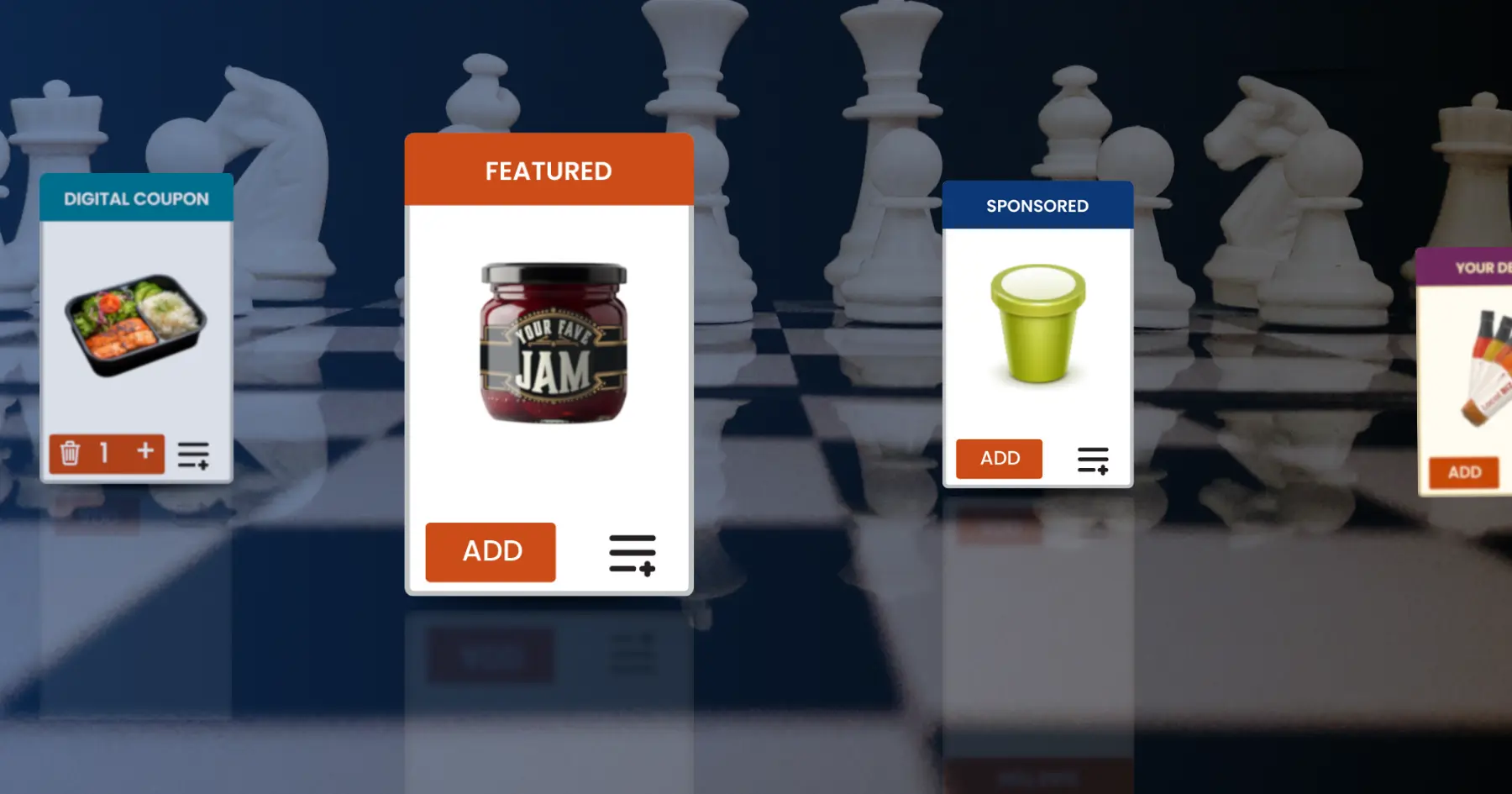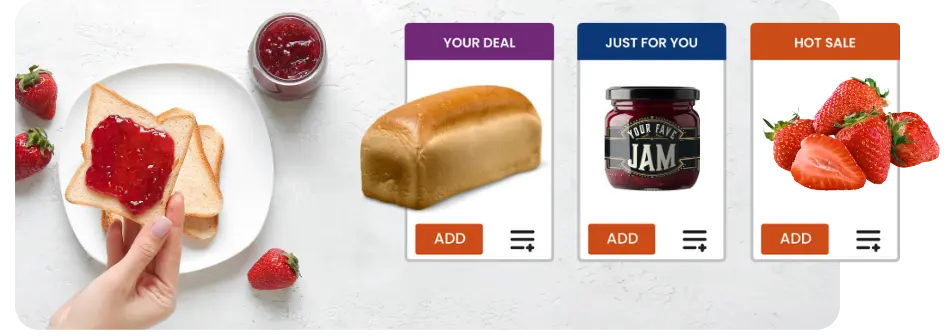
5 Retail Media Strategies to Drive Online Grocery Advertising Revenue
This article was originally published on October 27, 2020 with the title “5 Ways Online Grocery Advertising Can Generate Revenue For Your Business.” It was revised on October 7, 2024.
A new revenue stream and improved market position? It almost sounds too good to be true.
But the opportunities presented by incorporating retail media into digital platforms are real for grocers—very real.
Retail media revenue reached almost $50 billion last year. According to research from the Interactive Advertising Bureau and PwC, this massive figure is only set to grow in the coming years.
For a grocery industry beleaguered by increased competition from mass merchants and a cross-shopping surge that hasn’t let up since the pandemic, this figure represents a crucial chance to capture new revenue.
But while most grocery retailers recognize the massive potential of retail media, few have fully capitalized on the opportunity it presents. This is largely due to two significant obstacles that stand in the way of grocers trying to tap into this lucrative market.
Big Player Dominance
The first challenge is the overwhelming dominance of big retailers like Amazon and Walmart, who have already established their own retail media networks, capturing a substantial share of the available advertising dollars from consumer packaged goods (CPG) brands.
This dominance stems in part from the significant head start these retail giants have in developing and optimizing their retail media networks. Their vast customer bases and advanced data analytics make them highly attractive to CPG brands, eager to invest where they can achieve the greatest impact.
Lack of Infrastructure
The second challenge is the complexity of setting up and managing a successful retail media strategy, especially for grocery stores that lack the necessary infrastructure and expertise to effectively monetize their digital platforms.
Traditionally, grocers have struggled to tap into this revenue stream because they either rely on third-party delivery partners or lack a robust first-party platform. Those with a heavy dependence on third parties for online grocery sales often cede CPG ad revenue to them. Grocers who manage their own eCommerce channels quickly realize that building and sustaining a retail media program is far more challenging than anticipated.
Seizing the Opportunity Presented by Retail Media
When these two challenges are considered in tandem, it's clear that grocery retailers must act quickly and effectively to secure their share of the rapidly growing retail media market.
This article will guide grocers through the complexities of retail media, offering actionable steps to help them compete with the biggest players and more effectively monetize their digital platforms.
By implementing these strategies, grocers can finally turn the potential of retail media into a profitable reality.
How Retail Media Benefits Grocery Stores
We'll begin with the basics: How exactly does retail media stand to help grocers?
Retail media enables grocery retailers to monetize their websites and eCommerce platforms by allowing consumer packaged goods (CPG) brands to advertise directly to grocery shoppers during their online shopping experience.
These marketing efforts can be achieved through a variety of digital ad formats, such as sponsored product listings, banner ads, and personalized promotions, which are seamlessly integrated into the grocer’s website or mobile app.

These ads are designed to reach consumers at the point of purchase as they buy their groceries online, making them highly effective for both the advertiser and the retailer.
Retail Media Creates Additional Revenue for Online Grocery Shopping
CPG brands are willing to pay a premium to advertise through online grocery platforms like this because it gives them direct access to online shoppers who are ready to buy.
This revenue comes in the form of advertising fees paid by CPG brands to the grocer, based on the visibility and performance of their ads.
As retail media continues to grow, this revenue source becomes increasingly significant. It offers grocers a way to capitalize on the value of their digital platforms without having to increase product prices or rely solely on grocery sales margins.
These ads can also be personalized to individual customers. This provides an online grocery shopping experience that feels made specifically for them—which further contributes to both larger basket sizes and increased customer loyalty.
Retail Media Offsets Costs for Online Grocery Stores
The revenue generated from retail media can be used to offset the costs of running and expanding grocery eCommerce services.
It can be expensive to implement and operate an eCommerce platform. In addition to startup costs, there are other expenses, from website maintenance to order fulfillment and customer service. By monetizing their digital real estate through retail media, grocers can cover a portion—or even all—of these costs.
This, in turn, frees up capital that can be reinvested into other areas of the business, such as:
- Enhancing the online grocery shopping experience to create more loyal customers;
- Expanding fulfillment options for customers buying groceries online; or
- Offering competitive pricing to attract more in-store and online grocery shoppers.
Retail Media Expands Relationships with CPG Brands
Retail media also serves as a powerful tool for deepening relationships between CPG and grocery brands.
By providing valuable advertising space on their digital platforms, grocers offer CPGs a direct line to their online grocery shoppers, enhancing brand visibility and driving grocery sales. In return, CPG brands are more likely to invest in co-marketing opportunities, exclusive product launches, and other collaborative initiatives that benefit both CPG and grocery brands.
Additionally, the data generated from these marketing efforts—such as online grocery shopping behaviors and ad performance—can be shared with CPG partners, helping them refine their strategies and strengthen their partnerships with online grocers even further.
The end result is a win-win-win scenario for grocers, CPG brands, and grocery shoppers alike.
5 Effective Strategies for Retail Media Success
More online grocery sales, better relationships with suppliers, and improved customer loyalty all add up to the increased ad revenue to make the potential for profits immense. But to fully capitalize on this opportunity, grocers must approach retail media strategically.
The following step-by-step guide will help you set up your grocery business for success, ensuring your retail media efforts are well-targeted, effective, and capable of driving sustained growth.
1. Evaluate eCommerce Traffic and Order Data
The first step in building a successful retail media strategy is to gather a complete understanding of the online grocery shopping experience for your customers, including your eCommerce traffic and order data.
Start by evaluating the volume of traffic across various parts of your site—such as the home page, product pages, and checkout pages—and break it down by device type, including web versus mobile.
Beyond just raw numbers, assess the quality of this traffic: Are visitors browsing multiple pages, or are they bouncing quickly? What is the conversion rate across different segments? Additionally, understanding the average order value and consumer behavior provides insights into what kind of return advertisers can expect on their investments.
This data-driven approach will form the foundation of your strategy, guiding everything from ad placement to online grocery revenue projections.
2. Choose the Right Retail Media Solution
With your data in hand, the next step is to select a retail media solution that aligns with your business needs and operational capabilities.
When choosing a partner or platform, consider factors such as brand coverage—whether the network can attract the types of brands you want to work with—types of ads offered, and budget requirements, including both national and regional considerations.
A crucial aspect to evaluate is the required lift, meaning the amount of work your team will need to handle versus what the network will manage. For many regional grocers, it’s important to find a partner that can provide comprehensive support, especially if in-house resources are limited.
The right solution should not only meet your current needs but also scale with your business as it grows.
3. Capitalize on Both Web and Mobile Traffic
Mobile traffic typically accounts for more than half of eCommerce orders. And yet, many retailers focus their retail media efforts on their site's desktop version.
To ensure you're effectively driving impressions and interactions for your CPG partners, it's essential that your retail media strategy effectively targets all online grocery shopping options, including desktop, mobile and app environments. This means ensuring that ads are optimized for smaller screens and that mobile users—whether via browser or eCommerce apps—have a seamless customer experience.
By capturing mobile traffic effectively, you can maximize your advertising reach and, consequently, your return on investment (ROI). Consider the different behaviors of mobile versus desktop users when planning your ad placements and messaging.
4. Develop In-House Expertise
As your retail media strategy gains traction, developing in-house expertise becomes increasingly important.
This starts with managing ad placements through your eCommerce platform’s content management system (CMS), which allows you greater control over where and how ads are displayed. Additionally, fostering direct relationships with CPG brands can lead to more personalized and effective advertising campaigns.
By building these capabilities internally, you not only increase your control over the ad inventory but also position your business to offer a more seamless omnichannel experience, integrating online grocery shopping with in-store promotions.
As your team becomes more skilled, you’ll be able to identify new revenue opportunities and optimize existing ones more effectively.
5. Monitor Key Metrics
The final step is to continuously monitor the performance of your retail media efforts.
Key metrics to track include the number of advertised products, ad fulfillment rates, click-through rates (CTR), conversion rates, and Return on Ad Spend (ROAS).
For those new to retail media, starting with CTR and conversion rates can help you understand how consumers are interacting with your ads while grocery shopping. As your strategy matures, ROAS will become a critical metric to ensure that your advertisers are achieving a strong return on their investment.
Regularly reviewing these metrics allows you to make data-driven adjustments to optimize ad performance, improve customer engagement, and ultimately increase revenue. Remember, successful retail media is not a set-it-and-forget-it approach; it requires ongoing analysis and refinement.
Mercatus Delivers the Full Potential of Retail Media to Grocers
Mercatus makes it easy for grocers to implement the strategies identified above with a suite of solutions designed to drive more eCommerce sales and seamlessly integrate personalized retail media promotions into the digital customer experience.

With Mercatus Retail Media, grocers can quickly tap into this growing revenue source through retail media ads that align with your brand standards, engage your customers, and boost online shopping sales.
That means you can focus on your core business while we monetize your grocery brand's digital real estate, through:
Data-driven Insights
Gain powerful analytics that allow you to evaluate your eCommerce traffic and order data, helping you make informed decisions to optimize your retail media strategy and maximize revenue.
Seamless Web and Mobile Integration
Our platform ensures that your retail media efforts are fully optimized across both web and mobile environments, providing a consistent and engaging experience for your customers.
Real-time Performance Monitoring
Track key metrics like click-through rates, conversion rates, and ROAS in real-time, allowing you to continuously refine and improve your campaigns for sustained growth.
In-house Expertise
We empower your team to manage ad placements and build direct relationships with CPG brands, helping you create a seamless omnichannel experience that strengthens both online and in-store operations.
Mercatus is a true technology partner to grocery retailers. That means we provide more than just a plug-and-play solution. We work closely with you to ensure your retail media strategy is fully optimized.
It’s time to claim your share of digital ad revenue, with a simple solution that empowers you to take advantage of a new revenue stream for your grocery business.
Learn how to maximize the revenue potential of your eCommerce site, by booking a demo today.
 Newsroom
Newsroom
